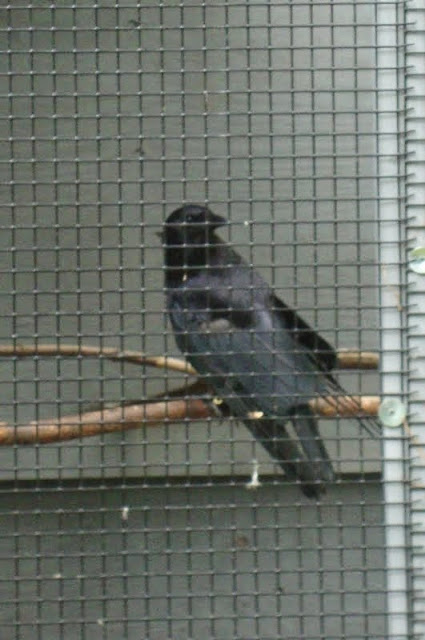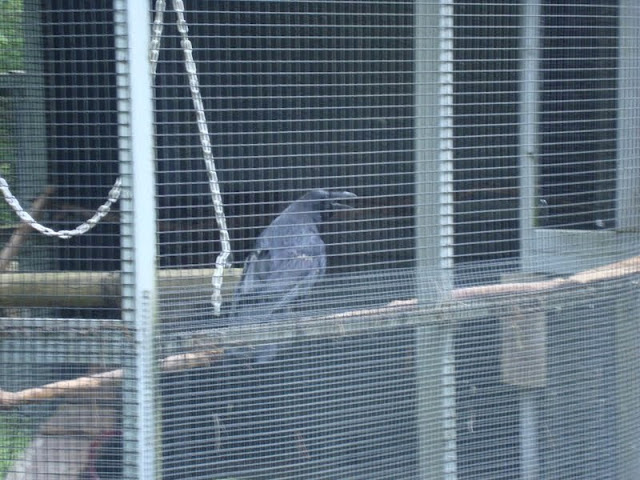Spreading our Wings: Exploring the Local Raptor Center
We met with a new homeschool group today at Horizon Wings Raptor and Education Center. The boys had so much fun learning all about falcons, hawks, owls, vultures, bald eagles and other birds.
Not that surprisingly, Alec knew most of the answers to all the questions (and even interrupted the lady speaking a few times so that I had to remind him not to interrupt!).
We learned (or re-learned, in some cases):
Linking Up With:

Not that surprisingly, Alec knew most of the answers to all the questions (and even interrupted the lady speaking a few times so that I had to remind him not to interrupt!).
We learned (or re-learned, in some cases):
- That, in birds of prey, the females are larger than the males.
- The Barred owl's call sounds like "who cooks for you?"
 |
| Barred owl |
- That almost all birds bald eagles will steal food from other birds, that Ben Franklin did not want the bald eagle as our nation's symbol because he thought it was a lazy and dishonest bird (since it eats carrion and steals from others). When asked who knew what bird Ben Franklin did want to be the national symbol Alec's hand shot up and he answered "the turkey" without hesitation. I had no idea he knew that and I couldn't help but wonder, once again, where he learned that!
 |
| Bald eagles are not born with white head feathers |
 |
| The bald eagle pants to keep cool and when he's nervous |
- The screech owl was hit by a car and then run over by another car (and lived!). Her "ear" tufts are not ears but fur and they help her with her camouflage.
 |
| Screech owls |
- You can tell a raven from a crow because a raven is bigger and has a much larger beak and they'll row their wings like an oar while crows flap their wings.
 |
| Crow |
 |
| Raven |
- The screech owl is the second smallest owl in north America, the Saw- Whet is the smallest.
- We got to hear the sounds of the ravens, crows, and peregrines falcon.
- The Great horned owl is the largest species in North America and they love to eat skunks. The lady was telling us that even baby horned owls they come across smell of skunk. Owls don't have a good sense of smell so the skunk smell doesn't bother them and skunks are slow moving nocturnal animals that they find easy to catch and bring home to feed their young.
- The saw- whet owls will cover their face with their wings to camouflage themselves further.
 |
| Saw-Whet owls |
- Most birds in captivity live longer than would in the wild
- One thing that is hurting all the animals are pesticides and chemicals. Those that we spray on plants or use to kill rodents are both equally harmful. DDT almost killed off several species of birds when they became calcium deficient and their eggs were so fragile that they broke when the birds sat on them. The birds are also more likely to catch mice and rodents that are slow, hurt and weak (or poisoned) and when they eat these animals the poisons are stored in their bodies.
- When a red tailed hawk steals a baby crow from it's nest all the crows will mob the hawk until the hawk gives up the baby and flies away. If you look for a mob of birds you might see a hawk.
- We learned that red tailed hawks don't have red tail feathers until they are older.
 |
| Red tailed hawks have a "belt" band of darker feathers around their lower body |
- The peregrine falcon can fly 240 mph. It's the fastest animal on Earth. They are used at airports to scare birds away. While fighter jet pilots experience up to 5 G's, peregrine falcons can go up to 20-30 G's (or something like that-- we know it was A LOT more than man!). When falcons are coming up out of a dive, fighting against gravity, experiencing the G- Force they have an equivalent weight of about 60lbs. Their bodies can absorb this sock because they have a bigger heart, a harder chest cavity/bone, they have larger arteries and veins to pump oxygenated blood through them faster, and they have a way to control the air coming into their nose nostrils.
- We also learned that turkey vultures fly with their wings out in a V while black vulture flies with it's wings out like a normal bird. The turkey vulture has a god sense of smell but the black vulture has a good sense of sight. The black vulture with fly with turkey vultures since they're more likely to lead them to carrion but then the black vulture will scare off the other turkey vultures.
the black vulture
- Kestrels, though small, are still birds of prey. Kestrels like to live on the edge of fields. The males are more brightly colored than the females.
 |
| American Kestrel |
- A pair of barn owls with their young can eat up to 1,000 mice in a three month time period.
 |
| Barn Owl |
- The broad wing hawk flies south to Central and South America for the winter in groups called kettles. They like to live in wooded areas near swamps and streams. Their numbers are declining in Ct due to habitat loss of their summer homes down south and competition for food with the more aggressive red shouldered hawk.
 |
| Broad Winged hawk |
- Red shoulder hawks are highly aggressive and there were even reports of red shouldered hawks attacking a few people in one town. The hawks had built a nest near the school and after a few people were dive bombed upon and hurt with the birds sharp talons the male was removed from the nest and the female flew away to find a new mate.
Linking Up With:










My husband has taken a couple of hurt birds to our rehab center but I have never been. I've been meaning to ask him to take me. Now I know I need to for sure! Loved your post.
ReplyDelete:) gwingal
Thanks! It's so neat to see and hear what they can do and how these birds adapt.
DeleteWhat a great way for kids to see these amazing creatures up close!
ReplyDeleteIt was amazing! I loved that we could ask all our questions too.
Delete